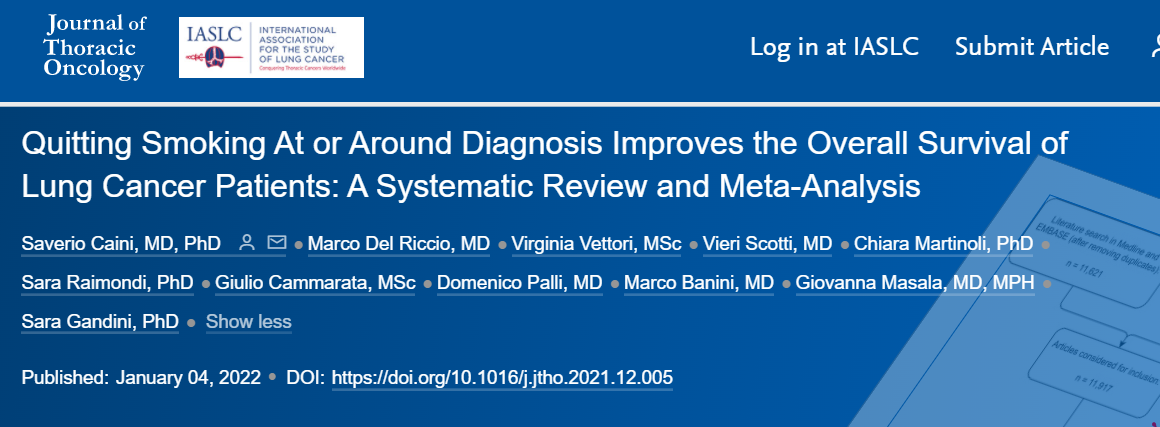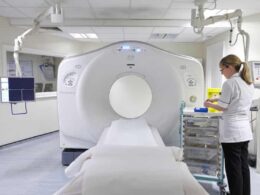Linkedin
Dr. Carlos Gil Ferreira
7 de Fevereiro de 2022
newsmedical
Esta é uma republicação do post abaixo, postado pelo Dr. Carlos Gil Ferreira em seu linkedin de hoje. O Editor deste blog adicionou à 2a parte desta publicação um excerto do artigo original ao qual o Dr. Ferreira faz referência, para os interessados em mais detalhes.
Key messages:
by Joaquim Cardoso MSc.
Chief Editor of “The Health Strategist” blog
- O câncer de pulmão continua sendo uma doença com prognóstico geralmente ruim, apesar dos avanços ocorridos na última década, principalmente por ser uma doença silenciosa e, em geral, diagnosticada tardiamente.
- Os pacientes com câncer de pulmão que param de fumar no momento do diagnóstico ou por volta dele podem viver quase um terço (29%) mais do que os pacientes que nunca param.
- Os médicos deveriam educar os pacientes de Câncer de Pulmão (LC) sobre os benefícios de parar de fumar, mesmo após o diagnóstico do câncer, e fornecer aos pacientes o necessário apoio para pararem de fumar (ex. Programas para Parar de Fumar)
Post Completo
Linkedin
Dr. Carlos Gil Ferreira
7 de Fevereiro de 2022
Fumar é o principal fator de risco para o câncer de pulmão.
Segundo dados do INCA (Instituto Nacional do Câncer) o tabagismo tem relação com vários tipos de câncer e é responsável por cerca de 90% das mortes por câncer de pulmão.
Parar com o hábito pode não ser tão simples assim, já que a nicotina é considerada droga e pode levar a dependência química, mas uma pesquisa recente pode servir de incentivo para que muitos fumantes procurem ajuda.
Em estudo publicado em janeiro no Journal of Thoracic Oncology, foi realizada uma revisão sistemática de um total de 21 artigos publicados em um intervalo de tempo de quase três décadas (1980–2021), abrangendo um total de mais de 10.000 pacientes com câncer de pulmão de células não pequenas (o tipo mais comum), câncer de pulmão de pequenas células e/ou câncer de pulmão de tipo não especificado.
Apenas estudos focados em pacientes que pararam de fumar quando diagnosticados com câncer de pulmão, durante o tratamento ou nos 12 meses anteriores ao diagnóstico foram incluídos.
A conclusão foi de que os pacientes com câncer de pulmão que param de fumar no momento do diagnóstico ou por volta dele podem viver quase um terço (29%) mais do que os pacientes que nunca param.
O câncer de pulmão continua sendo uma doença com prognóstico geralmente ruim, apesar dos avanços ocorridos na última década, principalmente por ser uma doença silenciosa e, em geral, diagnosticada tardiamente.
Por isso, uma descoberta como esta pode significar um ganho potencialmente grande na sobrevida desses pacientes.
#oncology #oncologiatorácica #câncerdepulmão #prevenção #fiqueatentoaossinais #procureseuespecialista #vencerocâncer #câncertemtratamento #ninguémmerecetercâncer
#nuncaétardeparaparardefumar
ORIGINAL PUBLICATION

Quitting Smoking At or Around Diagnosis Improves the Overall Survival of Lung Cancer Patients: Systematic Review and Meta-Analysis
JTO — Journal of Thoracic Oncology
Saverio Caini, MD, PhD; Marco Del Riccio, MD; Virginia Vettori, MSc; Vieri Scotti, MD; Chiara Martinoli, PhD; Sara Raimondi, PhD; Giulio Cammarata, MSc; Domenico Palli, MD; Marco Banini, MD; Giovanna Masala, MD, MPH; Sara Gandini, PhD
January 04, 2022
ABSTRACT
Introduction
Lung cancer (LC) remains a disease with poor prognosis despite recent advances in treatments.
Here, we aimed at summarizing the current scientific evidence on whether quitting smoking at or around diagnosis has a beneficial effect on the survival of LC patients.
Methods
We searched MEDLINE and EMBASE for articles published until 31st October, 2021, that quantified the impact on LC patients’ survival of quitting smoking at or around diagnosis or during treatment. Study-specific data were pooled into summary relative risk (SRR) and corresponding 95% confidence intervals (CI) using random effect meta-analysis models.
Results
Twenty-one articles published between 1980 and 2021 were included, which encompassed a total of over 10,000 LC patients.
There was substantial variability across studies in terms of design, patients’ characteristics, treatments received, criteria used to define smoking status (quitters or continued), and duration of follow-up.
Quitting smoking at or around diagnosis was significantly associated with improved overall survival (SRR 0.71, 95% CI 0.64–0.80), consistently among patients with non-small cell LC (SRR 0.77, 95% CI 0.66–0.90, n studies = 8), small cell LC (SRR 0.75, 95% CI 0.57–0.99, n studies = 4), or LC of both or unspecified histological type (SRR 0.81, 95% CI 0.68–0.96, n studies = 6).
Conclusions
Quitting smoking at or around diagnosis is associated with a beneficial effect on the survival of LC patients.
Treating physicians should educate LC patients about the benefits of quitting smoking even after diagnosis and provide them with the necessary smoking cessation support.
Quitting smoking at or around diagnosis was significantly associated with improved overall survival

This is an excerpt of the long version of the publication.
Introduction
Lung cancer (LC) is among the most common and deadliest malignancies worldwide.
According to Global Cancer Incidence, Mortality, and Prevalence, LC ranks second globally in terms of incidence, with
- over 2.2 million new cases estimated to have occurred in 2020, and first in terms of mortality, with
- nearly 1.8 million caused deaths. 1
Despite the continuous improvement of treatment modalities (i.e. immunotherapy, new targeted therapies, radiotherapy, etc.), the prognosis of patients with LC remains dismal in comparison with tumors at other body sites, as the 5-year relative survival rate is 25% (all stages combined) for the NSCLC type and 7% for SCLC according to data from the U.S. Surveillance, Epidemiology, and End Results program.2
Cigarette smoking is, by far, the most important modifiable risk factor for LC occurrence, accounting for nearly two-thirds of all LC cases globally according to the latest report from the Global Burden of Disease initiative.3
The fight against tobacco use (which should include the issuing of strict tobacco control laws and active bans on the advertising, promotion, and sponsorship of tobacco products, and the adoption of other measures as detailed in the WHO Framework Convention on Tobacco Control)4 is the cornerstone of LC prevention globally, and should primarily aim at preventing the initiation of smoking among teenagers and young adults. 5
It is also key that smokers are actively encouraged to quit smoking and given adequate support when making an attempt to quit or exhibiting a willingness to try because maintained smoking cessation substantially reduces LC mortality (and all other major cause-specific mortality) over time. 6
It is comparatively much less clear to date whether smokers diagnosed with LC have survival advantages if they quit smoking at or around diagnosis. In a systematic literature review and meta-analysis published in 2010 (which encompassed articles published up to December 2008), Parsons et al. 7 found suggestive evidence that quitting smoking at or around diagnosis could lead to an improvement in the recurrence-free survival and overall survival (OS) of patients with LC. However, the strength of the conclusions that could be drawn at the time was considerably curbed by the small number of studies available then regarding the topic (10, of which only six reported on the effect of smoking cessation on OS); all the more so when attempting to separately evaluate the two main types of LC (NSCLC and SCLC).
In recent years, the number of studies on the subject has been increasing, so that updating the previous meta-analysis seems appropriate and timely. Therefore, we conducted a systematic literature review and meta-analysis of the studies that evaluated the prognostic effect of quitting smoking at or around diagnosis among patients with LC.
Materials and Methods
See the original publication
Results
See the original publication.
Discussion
We conducted a systematic review and meta-analysis of articles published up to October 31, 2021 that investigated whether quitting smoking at or around diagnosis improved the survival of smokers diagnosed with LC.
A total of 21 articles published in a time range of nearly three decades (1980–2021) were included, which encompassed a total of over 10,000 patients with LC.
The studies differed under several aspects, including study design, patient demographics, duration of follow-up, treatments received, and criteria used to define quitters.
With regard to the latter point, we chose to include studies in which quitters were defined as those who ceased smoking either at LC diagnosis, during treatment, or shortly before (up to 12 mo) LC diagnosis.
These multiple sources of variability resulted in moderate heterogeneity of HR across studies, yet the results of the meta-analysis strongly pointed toward the existence of a beneficial effect of smoking cessation at or around diagnosis on patients on LC survival, which emerged with comparable magnitude (and always achieving statistical significance at the 0.05 level) in the studies restricted to either patients with NSCLC (SRR 0.77) or SCLC (SRR 0.75) and in studies that included patients of both LC types (SRR 0.81).
Our findings were strengthened when the analysis was restricted to those studies in which patients with LC labeled as quitters were those who had stopped smoking strictly at or after LC diagnosis because the observed improvement in patients’ OS associated with smoking cessation was maintained and enhanced.
Finally, quitting smoking at or around diagnosis also seemed to positively affect the patients with LC’s disease-free survival, although the limited number of available studies advised against calculating a pooled estimate.
To the best of our knowledge, only a single meta-analysis has been published to date that evaluated the relationship between around or postdiagnosis smoking cessation and LC survival.
Parsons et al. 7 found suggestive evidence of a harmful effect of smoking continuation on LC survival; however, their conclusions for OS were on the basis of only four (for NSCLC) and two (for SCLC) observational studies published up to December 2008.
Here, we updated the work of Parsons et al. 7 by substantially increasing the number of reports that were included, and we confirmed and reinforced their early claims.
There are several plausible biologic mechanisms able to explain the observed effect of smoking cessation on patients with LC’s survival.
Tobacco smoke promotes tumor growth, progression, and dissemination; decreases the efficacy of, and tolerance to, radiation and systemic therapy; and increases the risk of postoperative complications and second primary cancers. 39 , 40 , 41
The underlying mechanisms are mostly unknown and very little data are available, but an important role may be played by the epigenetic changes induced by tobacco smoke and its cessation, with, for instance, interesting data that suggested an impact on smoking cessation survival-benefit according to DNA methylation level in patients with lung adenocarcinoma. 42
It is important, however, to acknowledge that several sources of bias may also be at play, particularly confounding, arising from systematic differences between quitters and continued smokers that are insufficiently (or not at all) adjusted for in the analyses.
For instance, quitters might differ from continued smokers in terms of demographics (e.g. age) or tumor characteristics (e.g. stage) that affect survival.
In addition, patients with LC who manage to quit and remain abstinent after diagnosis might be more likely to receive resection with curative intent and, inversely, it could be hypothesized that patients with LC with lower-stage cancer might be more motivated to quit smoking to enhance their likelihood of recovery.
However, studies that looked at predictors of smoking cessation after LC or cancers at other sites have provided highly conflicting results, 43 , 44 , 45 , 46 and a higher odds of quitting among those with more advanced (instead of localized) stage cancers was observed in the United States in a large investigation on the basis of data from Surveillance, Epidemiology, and End Results. 47
Because of this uncertainty, it would have been of the utmost importance that all possible confounders (factors that affect both the likelihood of quitting smoking and survival) were adjusted for in the analyses, although this was not the case in all of the studies included in the present meta-analysis. Whereas our findings strongly suggest a beneficial prognostic effect of smoking cessation, it remains uncertain how much of this effect is because of residual confounding possibly affecting some of the studies.
A further point to consider is that the included papers gave scarce attention to the effect of smoking cessation on the efficacy of subsequent or ongoing therapy. In fact, there is not much updated data available to evaluate the effect of continued smoking with regard to the different therapeutic options currently available to treat patients with LC, and further studies are urgently needed, especially considering the introduction of immunotherapy in the extended-stage SCLC setting and the fact that OS and PFS can differ consistently when considering oncogene versus non–oncogene-addicted NSCLC. Continued smoking during treatment surely has an impact on comorbidities, but it also seems to be true for treatment efficacy. For instance, O’Malley et al. 48 pointed out the increased clearance of medications such as erlotinib and irinotecan (with relative lower systemic exposure) in smokers compared with never- and former smokers, which may play a role in the resulting lower adverse events rates and outcome in such patients.
More attention has been given to the impact of smoking on the efficacy of immune checkpoint inhibitors.
Limited, yet suggestive data found greater benefit from immunotherapy in smokers, which could be explained by the association of smoking history with increased tumor mutational burden and programmed death-ligand 1 expression levels. 49 In contrast, chemotherapy seems to be more effective among nonsmokers. 50
Finally, it is worth emphasizing how former smokers achieved better survival outcomes than current smokers in the subgroup analyses of the KEYNOTE-024 trial, thus, also emphasizing in this specific clinical setting the importance to stop smoking among patients with LC as soon as possible at diagnosis. 51
The implications of our findings extend beyond the clinical setting. There is intense ongoing research on the feasibility and cost-effectiveness of LC screening programs. 52 , 53
Because heavy smokers would be primarily targeted, LC screening could serve as a “teachable moment” to help participants quit smoking by integrating a structured cessation program into the screening activities. 54 , 55
Our findings greatly support this view by illustrating that success in quitting smoking would benefit not only those testing negative from the screening tests but also those eventually diagnosed with LC.
The main strength of this systematic review and meta-analysis lies in the fair number of studies included, which allowed for obtaining summary estimates stratified by LC subtype and by the exact timing of smoking cessation.
The observed moderate heterogeneity in effect estimates across studies was, to some extent, unavoidable, given the multiple differences in study design, patient characteristics included, the definition of exposure, and duration of follow-up.
As a rule, the limitations affecting the studies that are pooled in meta-analyses can, in turn, affect the validity of the summary estimates that are calculated, and our meta-analysis is not an exception.
In addition to the aforementioned possibility of residual confounding, immortal time bias is a possible cause for concern because it can exaggerate the strength of an association or even generate a spurious association.
Immortal time bias can occur when the assessment of smoking status (quitters or continued) is done after a certain time (e.g. months) has elapsed since diagnosis, or when only patients with LC who have survived up to a given time after diagnosis are included in the analysis.
Moreover, smoking status was mostly self-reported and confirmed by more reliable methods (e.g. monitoring of exhaled carbon monoxide) only in a few studies. Finally, all studies included were conducted in high-income countries, whereas greater diversity under this regard would be desirable.
LC remains a disease with a generally poor prognosis, despite the advances that have occurred over the past decade, including the introduction of immune checkpoint inhibitors (alone or in combination) effective for both NSCLC and SCLC. 56 , 57
The articles that we reviewed and summarized here are still limited in number and have some limitations, particularly in study design and methods. Studies carefully designed to avoid confounding and other sources of bias, and investigating any interaction of changes in smoking status with the existing treatment options, are urgently needed.
Despite these limitations, the data currently available are, in our opinion, robust enough to conclude with the recommendation that inviting patients to quit smoking at diagnosis or during treatment or follow-up encounters, and giving them all the support necessary to succeed in their attempts to quit and remain abstinent during and after therapy, should arguably become a nonoptional part of the management of these patients given the potentially large gain in survival that can ensue.
References
See the original publication
About the authors & affiliations
Saverio Caini, MD, PhD;
Marco Del Riccio, MD
Virginia Vettori, MSc
Vieri Scotti, MD
Chiara Martinoli, PhD
Sara Raimondi, PhD
Giulio Cammarata, MSc
Domenico Palli, MD
Marco Banini, MD
Giovanna Masala, MD, MPH
Sara Gandini, PhD
Saverio Caini, MD, PhD,a, * Marco Del Riccio, MD,b Virginia Vettori, MSc,c Vieri Scotti, MD,d Chiara Martinoli, PhD,e Sara Raimondi, PhD,e Giulio Cammarata, MSc,e Domenico Palli, MD,a Marco Banini, MD,f Giovanna Masala, MD, MPH,g Sara Gandini, PhDe
a Cancer Risk Factors and Lifestyle Epidemiology Unit, Institute for Cancer Research, Prevention and Clinical Network (ISPRO), Florence, Italy
b Postgraduate School in Hygiene and Preventive Medicine, University of Florence, Florence, Italy
c Department of Health Sciences, University of Florence, Florence, Italy
d Radiation Oncology Unit, Department of Oncology, Azienda Ospedaliero-Universitaria Careggi, Florence, Italy
e Department of Experimental Oncology, European Institute of Oncology (IEO), Istituto di Ricovero e Cura a Carattere Scientifico (IRCCS), Milan, Italy
f Department of Biomedical, Experimental, and Clinical Sciences “Mario Serio,” University of Florence, Florence, Italy
g Clinical Epidemiology Unit, Institute for Cancer Research, Prevention and Clinical Network (ISPRO), Florence, Italy
Originally published at https://www.jto.org.











